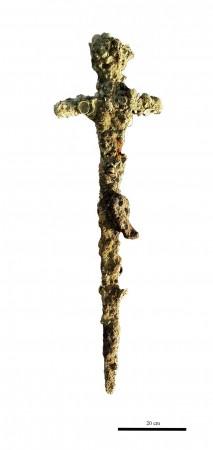It is known that divers often explore the deepest depths of the ocean for artifacts lost in time. From 'treasures'—as popularized by Hollywood—to remnants of ships to articles from famed vessels, there is much that is hidden in the heart of the sea. However, imagine stumbling across a 900-year-old crusader's sword while snorkeling for leisure? This is exactly what happened to an Israeli man.
Shlomi Katzin, a resident of Atlit in the Haifa District of Israel, stumbled across a hilted sword when he went diving off Carmel Beach. It is believed to have belonged to a crusader knight. Katzin handed it over to the Israel Antiquities Authority's (IAA) robbery prevention unit.
"The sword, which has been preserved in perfect condition, is a beautiful and rare find and evidently belonged to a Crusader knight," said Nir Distalfeld, supervisor of the IAA's robbery unit, in a statement
A Crusader's Sword

While diving off the beach on the northern coast of Israel on Saturday, Katzin spotted the barnacle-covered sword along with other artifacts such as ancient stone anchors, anchors made of metal, and pottery fragments. In a statement, the IAA explained that waves and undercurrents in the area shifted the sand, thereby, revealing the sword and other items.
Worried that the sea currents may rebury the ancient weapon or that someone else may chance upon it before the IAA did, Katzin picked it up instead of leaving it to chance. He tracked down the phone number of the inspector of the robbery prevention unit in the north and handed over the historical item.

The blade of the sword measures around 1 m (3.3 ft) in length. Its hilt is about 30 cm long. "It was found encrusted with marine organisms, but is apparently made of iron. It is exciting to encounter such a personal object, taking you 900 years back in time to a different era, with knights, armor and swords," described Distalfeld.
Site of Historical Importance
According to IAA's statement, the sword has been entrusted to the National Treasures Department. Eli Escosido, general director of IAA informed, "Once the sword has been cleaned and researched in the Israel Antiquities Authority's laboratories, we will ensure it is displayed to the public."
Explaining the features of the coast and its historical significance, Kobi Sharvit, Director of IAA's Marine Archaeology Unit, said, "The Carmel coast contains many natural coves that provided shelter for ancient ships in a storm, and larger coves around which entire settlements and ancient port cities developed, such as Dor and Atlit. These conditions have attracted merchant ships down the ages, leaving behind rich archaeological finds. The recently recovered sword is just one such find."
Since June, the IAA has been monitoring the site where the sword and anchors were discovered. The findings at the site are difficult to keep track of as the movement of the sands often leads to their appearing and disappearing.
"The archaeological finds at the site show that it served as a small, temporary natural anchorage for ships seeking shelter. Identification of the various finds shows that the anchorage was used in as early as the Late Bronze Age, 4,000 years ago. The recent discovery of the sword suggests that the natural cove was also used in the Crusader period, some 900 years ago," illustrated Sharvit.

















